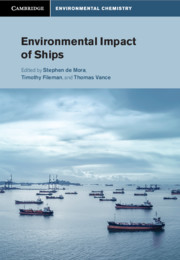Book contents
- Environmental Impact of Ships
- Cambridge Environmental Chemistry Series
- Environmental Impact of Ships
- Copyright page
- Contents
- Contributors
- Preface
- 1 Shipping, Ships and the Environment
- 2 Atmospheric Emissions from Ships
- 3 Oil Pollution from Operations and Shipwrecks
- 4 Waste and Sewage
- 5 Ballast Water
- 6 Biocides from Marine Coatings
- 7 Invasive Species
- 8 Physical Effects of Ships on the Environment
- 9 Ship Noise
- 10 Vessel Strikes and North Atlantic Right Whales
- 11 Nuclear-Powered Vessels
- 12 Environmental Impacts of Shipbreaking
- 13 International Legislative Framework
- 14 Shipping Industry’s Perspective
- 15 Environmental Impacts of Shipping
- Index
- References
4 - Waste and Sewage
Published online by Cambridge University Press: 22 January 2021
- Environmental Impact of Ships
- Cambridge Environmental Chemistry Series
- Environmental Impact of Ships
- Copyright page
- Contents
- Contributors
- Preface
- 1 Shipping, Ships and the Environment
- 2 Atmospheric Emissions from Ships
- 3 Oil Pollution from Operations and Shipwrecks
- 4 Waste and Sewage
- 5 Ballast Water
- 6 Biocides from Marine Coatings
- 7 Invasive Species
- 8 Physical Effects of Ships on the Environment
- 9 Ship Noise
- 10 Vessel Strikes and North Atlantic Right Whales
- 11 Nuclear-Powered Vessels
- 12 Environmental Impacts of Shipbreaking
- 13 International Legislative Framework
- 14 Shipping Industry’s Perspective
- 15 Environmental Impacts of Shipping
- Index
- References
Summary
Marine litter and waste has become one of the major environmental issues of the early twenty-first century. Around 6.4 million tonnes of litter are deposited into the oceans each year (UNEP, 2005), a figure that continues to grow as a result of a variety of social and economic factors, including consumerism and the purchase of single-use products, coastal urbanization, shipping, poor waste management and the use of plastics. Indeed, as Bergmann et al. (2015, p. x) noted, ‘The ubiquity of litter in the open ocean is prominently illustrated by numerous images of floating debris from the ocean garbage patches and by the fact that the search for the missing Malaysia Airlines flight MH370 in March 2014 produced quite a few misidentifications caused by litter floating at the water surface.’ Eriksen et al. (2014) estimated that there was a minimum of 5.25 trillion plastic particles weighing 268,940 tons afloat in the sea, but this figure does not include debris on beaches or on the sea floor. Galgani et al. (2015, p. 29) suggest that plastics ‘typically constitute the most important part of marine litter sometimes accounting for up to 100 % of floating litter’, while 90 per cent of litter caught in benthic trawls is also plastic (Galgani et al., 2015). However, it is important to note that even though the amount of plastic that is produced is increasing, and is expected to continue to do so in the future (Taylor, 2017), the ‘predominance of plastics in litter is not the result of relatively more plastics being littered compared to paper, paperboard or wood products reaching the oceans, but because of the exceptional durability or persistence of plastics in the environment’ (Andrady, 2015, p. 58).
- Type
- Chapter
- Information
- Environmental Impact of Ships , pp. 75 - 95Publisher: Cambridge University PressPrint publication year: 2020

